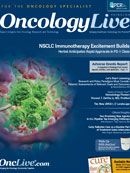Publication
Article
Oncology Live®
The Emerging "N-of-1" Model:Clinical Relevance of Individualized Tumor Profiling Grows in Research Programs
Author(s):
Molecular studies are increasingly utilized to develop an individual therapeutic approach based on abnormalities present in the setting of uncommon/rare cancers or in specific clinical situations where it is virtually certain that formal regulatory-based trials will never be undertaken.
Maurie Markman, MD
Editor-in-Chief of OncologyLive
Senior vice president for Clinical Affairs and National Director for Medical Oncology Cancer Treatment Centers of America, Eastern Regional Medical Center
A dramatic response in one patient with ROS1-positive non—small cell lung cancer who was treated with crizotinib enabled researchers to expand an early study and confirm the benefit of the targeted agent for this patient population. This research exemplifies the “N-of-1” paradigm and its exciting potential. The recently reported results of an expanded phase I clinical trial that evaluated crizotinib in a group of patients with advanced non–small cell lung cancer (NSCLC) whose tumors were demonstrated to possess a ROS1-rearrangement provides one more highly clinically relevant example of a rapidly evolving novel approach to cancer research.1
The dose of crizotinib employed was 250 mg twice a day. The safety of the agent in this analysis was similar to that previously reported for this targeted antineoplastic drug. The study revealed a 72% objective response rate in the overall patient population with a median duration of response of 17.6 months and a median progression-free survival of 19.2 months among the 50 individuals entered into this trial. Three complete responses were noted among the treated group.
Perhaps even more striking—one might use the term startling—is the fact that at the time of this report, one-half of the treated population remained in follow-up for disease progression. Thus, some of these impressive clinical responses are ongoing and it remains uncertain just how long they will persist.
However, the point of this commentary is not to highlight this definitive and landmark report that unequivocally changes the standard of care in this clinical setting, but rather to note the initial observation that led to this paradigm-altering clinical outcome.
In an earlier Journal of Clinical Oncology report describing the basic preclinical and highly rational clinical justifications for employing crizotinib in this particular setting, researchers describe as clearly as can be stated the concept of “N-of-1” clinical cancer investigation2:
“To determine whether ROS1 rearrangement confers sensitivity to ROS1 inhibition in patients, we enrolled a ROS1-positive patient with advanced NSCLC into an expansion cohort of the early phase study of crizotinib. …The patient is a 31-year-old male never-smoker diagnosed with multifocal bronchioloalveolar carcinoma in August 2010. …He was treated at an outside institution with first-line erlotinib with no response. As a result of progressively worsening symptoms and hypoxia, he was referred to MGH [Massachusetts General Hospital] for additional genetic testing and was found to be ROS1 positive. On April 20, 2011, the patient was started on crizotinib. …In less than 1 week, he noted a significant improvement in symptoms, and by 2 weeks, his hypoxia had resolved. Restaging scans at 8 weeks demonstrated near complete resolution of his multifocal lung tumor, which was subsequently confirmed at 12 weeks.”2
It is absolutely critical to acknowledge here that the point of highlighting this brief case presentation is not to suggest that all patients treated in an “N-of-1” clinical research effort will experience such a dramatic response, but rather to strongly state that, without such attempts to favorably influence the outcome of disease in individual patients in such situations, it is virtually certain that progress in the management of patients with cancers possessing well-characterized uncommon or quite rare molecular targets will be severely hindered or even completely halted.
It must be noted here that ROS1 abnormalities are found in only approximately 1% of patients with NSCLC.1 And even with the tremendous interest generated by this early observation among clinicians and clinical investigators and the understandable desire to treat patients with this molecular abnormality with crizotinib on the expanded phase I trial, it took these researchers approximately 3 years (October 2010 through August 2013) to enter a total of 50 patients into this study.1
Consider how long it would take to find an adequate number of patients to conduct a socalled evidence-based randomized phase III clinical trial in this specific patient population. How much more time would be required if we were discussing a malignancy or a particular clinical setting where the overall population available for evaluation is far more limited than it is with advanced NSCLC? Is it reasonable that patients, their families, and society will want to wait a decade or much longer to determine the presence or absence of the clinical utility of a given targeted antineoplastic in the setting of a well-defined theorized actionable molecular target?
Hopefully, in the future it will be possible to create an online publically available national repository of “N-of-1” experiences where such individual cases including both favorable and unfavorable responses/outcomes are accurately reported (with all individual patient identifiers completely removed). Further, all interested parties— future patients and their families, oncologists, primary care physicians, pharmaceutical/ biotech companies, the FDA, other governmental agencies, insurers, employers—would be able to view in close to real time the data generated during these experiences (with posting following objective confirmation of outcome).
Notably, one of the stated goals of the American Society of Clinical Oncology’s impressive CancerLinQ effort is to accomplish this essential task.3
Maurie Markman, MD, editor-in-chief, is president of Medicine & Science at Cancer Treatment Centers of America, and clinical professor of Medicine, Drexel University College of Medicine. maurie.markman@ctca-hope.com.
References
- Shaw AT, Ou SH, Bang YJ, et al. Crizotinib in ROS1- rearranged non—small-cell lung cancer [published online September 27, 2014]. N Engl J Med. doi:10.1056/ NEJMoa1406766.
- Bergethon K, Shaw AT, Ou SH, et al. ROS1 rearrangements define a unique molecular class of lung cancers [published online January 3, 2012]. J Clin Oncol. 2012;30(8):863-870.
- Schilsky RL. Implementing personalized cancer care [published online April 1, 2014]. Nat Rev Clin Oncol. 2014;11(7):432-438.









